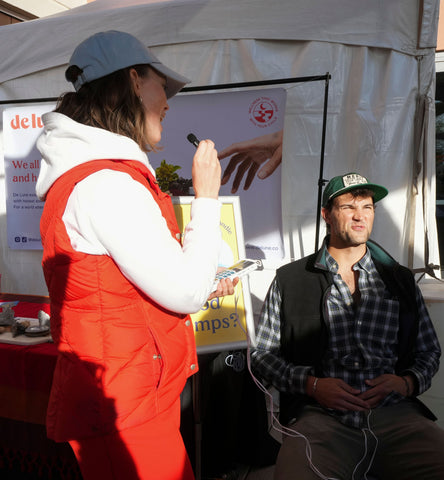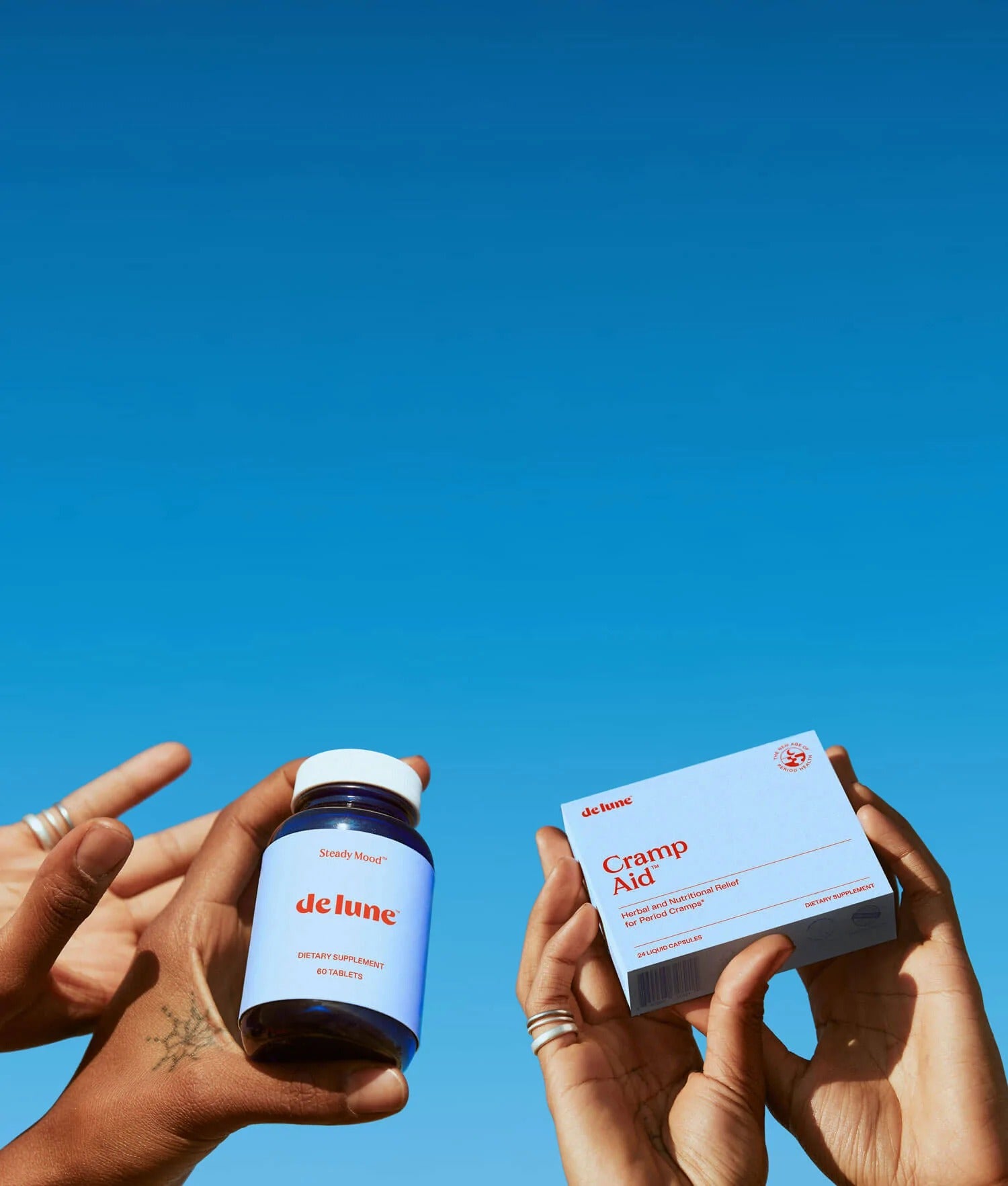You know when you’ve been crazy emotional all week and you assume Mercury is in retrograde? Then you get your period and you’re like… oh 🙄
It’s not the cosmos. It’s PMS—a legitimate medical condition that can cast a dark cloud over an entire week of your life, every single month.
But that doesn’t mean you have to suffer through it. This article discusses:
- What PMS is
- Why PMS happens
- And importantly, what you can do about it
What is PMS?
‘PMS’ is short for ‘Premenstrual Syndrome’. It’s an umbrella term for the cluster of physical, emotional, and/or behavioral symptoms that can present as early as 10 days before your period starts, and can last until your period ends.1
Symptoms
PMS is a mood, brain, and body experience. There are over 200 possible PMS symptoms documented in the scientific literature,2 but common ones include:3
-
Physical: headaches and migraines, dizziness, nausea, sensitivity to light and sound, acne, tender or swollen breasts, bloating, muscle aches, joint pain, back pain, constipation, diarrhea, gas, and swelling in the hands and feet
-
Emotional: anxiety, depression, irritability, mood swings, confusion, tension, loneliness, and aggression
-
Behavioral: fatigue, food cravings, crying, social disengagement, trouble concentrating, sleep disturbances, and low libido
It’s common to have some of these symptoms but not others. It’s also common for your symptom profile to change month-to-month—both in severity and the types of symptoms you get—and get worse as you age.4
Prevalence
Up to 90% of menstruators get at least one PMS symptom each month,5 yet only 10-15% of PMS sufferers seek medical assistance.6 These patterns are universal worldwide.7
PMS is tremendously emotionally, socially, and economically burdensome. PMS costs each menstruating human an average of $4,392 hard-earned dollars each year in direct and indirect expenses.8 70% of people with PMS report impaired work performance and loss of productivity.9
PMS-sufferers have significantly greater rates of relationship dissatisfaction and psychosocial distress.10 Up to 8% of people with periods experience a severe form of PMS called Premenstrual Dysphoric Disorder, or PMDD, in which symptoms are as disabling as a major depressive disorder.11
Why does PMS happen?
We know PMS is tightly linked to the luteal phase of the menstrual cycle, when levels of the reproductive hormones estrogen and progesterone rise, then fall dramatically.12
We also know people who use hormonal birth control, and have steady levels of estrogen and progesterone as a result, generally don’t PMS, or get very mild symptoms.3 These facts point to falling levels of estrogen and progesterone as the PMS culprit.
However! Two menstruating humans can have the exact same levels of circulating estrogen and progesterone, yet completely different PMS experiences. Two menstruating humans can also have very similar PMS experiences, yet completely different levels of circulating hormones.
For example, the jury is still out on whether high or low progesterone makes for more PMS; there are convincing studies on both sides.13,14,15,16,17
These inconsistencies lead some scientists to believe that it’s not the hormones themselves that cause PMS, but the degree to which a menstruator is sensitive to them.Hormones interact with the body through a complex interplay of receptors and neurotransmitters, and a bleeder’s susceptibility to PMS may lie somewhere in this interplay.
Hormone receptors live on all areas of the body, which could explain why PMS is a head-to-toe event. Neurotransmitters like dopamine and serotonin influence our emotions, perceptions, and behaviors, which could explain why PMS can manifest as anxiety, depression, irritability, compulsivity, and other brain-based symptoms.19
Some researchers have even found that hormone sensitivity (and thus, PMS severity) is genetic. Studies involving twins from the US,20 UK,21 and Australia22,23 show anywhere between 30 and 80% of PMS symptoms are inheritable.
Other researchers think PMS is less a matter of reproductive hormones, and more about metabolic energy. There’s an alternative theory (note: just a theory) that PMS is a condition of "impaired self-control"24 (the study authors' words, not ours).
Self-control is metabolically expensive. The theory posits that because considerable metabolic energy is allocated to the ovaries during the luteal phase of the menstrual cycle, less energy is available for the brain to control emotions and impulses. Thus, PMS symptoms manifest.24
There are flaws in this theory. It doesn’t explain the physical symptoms we mentioned above, like bloating, breast tenderness, and body aches. Nor does it explain why simply eating more calories doesn’t erase PMS symptoms. (But wouldn’t that be nice!)
Yet another group of researchers believe PMS is a sociocultural product—the sum of our environment, stressors, and past traumas, even those that happened long before one’s first period.
These researchers propose we hold memories in our bodies, as if the muscles and tissues remember previously inflicted pains. Trauma alters the hypothalamic-pituitary-adrenal (HPA) axis, a part of the brain that processes stressful situations and tells the rest of the body about them.
Studies show women with childhood traumas have a dysregulated HPA axis, a higher sensitivity to pain, and more PMS later in life.25 But this theory has its flaws too, as it doesn’t fully explain the connection between stress and the menstrual cycle, or why stressed cis-men don’t also get PMS.
So which of these theories should you believe? The largest body of science supports the hormone sensitivity theory, but the real answer may be some combination of all of them. PMS doesn’t get the scientific attention it deserves, and more research is needed.
Regardless of its underlying cause, PMS is neither "all in your head" nor a personal failing. PMS is real, and really disruptive. But it doesn’t have to be your monthly fate.
What you can do about PMS
Bleeders have three options for managing PMS: pharmaceutical drugs, lifestyle changes, and alternative medicine. Some of these options are better than others.
Pharmaceutical Drugs
Three types of pharmaceutical drugs are typically used to treat PMS: over-the-counter painkillers, antidepressants, and hormonal birth control.
Any of these may be useful for treating some (but not all) PMS symptoms in the short-term. But all of these drugs come with considerable risks in the long-term, and none address the whole problem.
- Over-the-counter painkillers can treat some of the physical symptoms of PMS, like sore muscles, back pain, and headaches. BUT, up to 60% of those who use these drugs experience some sort of adverse event.26 They also do nothing for emotional or behavioral PMS symptoms. Read more about why painkillers are *not* the answer to period problems here.
- Antidepressant drugs like Prozac and Zoloft—two types of Selective Serotonin Reuptake Inhibitors, or SSRIs—are prescribed to treat the emotional symptoms of PMS, but ignore the physical symptoms. Studies show 40-60% of people who use SSRIs experience no benefit at all from them.27 45% of Prozac and 40% of Zoloft users stop using these drugs due to side effects.28 And to make matters worse, their side effects mimic PMS symptoms, and include headaches, nausea, irritability, sexual dysfunction, weight gain, fatigue, dizziness, diarrhea, and sleep problems.29
- Hormonal birth control shuts down ovulation, thus preventing those hormonal peaks and crashes thought to trigger PMS. Of course, these drugs come with the benefit of preventing pregnancy, if that's your goal. But despite their usefulness as contraception, 57% of women prescribed birth control pills stop using them within 6 months, 34% citing side effects as the reason.30 Like antidepressants, side effects of hormonal birth control mimic PMS symptoms, and include weight gain, headaches, migraines, breast pain, mood disturbances, low libido, acne, and nausea.31 Everyone reacts to different types and formulations of hormonal birth control differently, so it may take a few tries to find one that’s right for you.
Lifestyle Changes
If drugs aren’t for you, there are also a number of lifestyle changes you can try, such as:- Regular aerobic exercise throughout the month32
- Eating a healthy diet rich in fruits, vegetables, whole grains, and lean proteins, and low in salt, sugar, alcohol, and caffeine33
- Getting at least 8 hours of quality sleep every night34
- Stress-management strategies, such as yoga and meditation35,36
- Not smoking37
Alternative Medicine
In our professional and common sense opinion, the best PMS therapies are both free of side effects and actually work. We see natural remedies like nutritional and herbal supplements as the only therapies that consistently meet both criteria.
According to womenshealth.gov, the best supplements for PMS include:
- Calcium. Studies show calcium helps reduce PMS symptoms like fatigue, cravings, and depression.38,39 The American College of Obstetricians and Gynecologists (ACOG) recommends PMS sufferers take calcium supplements.40
- Vitamin B6. Research says vitamin B6 is helpful for PMS symptoms like moodiness, irritability, forgetfulness, bloating, and anxiety.41 In clinical trials, vitamin B6 outperforms prescription antidepressants for treating mood-related PMS symptoms.42
- Magnesium. According to clinical studies, magnesium works in synergy with vitamin B6 to thwart PMS-related mood changes.43 Magnesium works alone, too. Research shows it can soothe menstrual migraines and reduce bloating.44,45
- Saffron, a vibrant spice with antioxidant and anti-depressant properties. Multiple studies show it can naturally tweak brain chemistry to lift the mood and curb an overactive appetite.46,47 In clinical trials, saffron is as effective as prescription medications for mild to moderate depression.48
- Rhodiola, an adaptogenic herb, has been used for millennia to quiet anxiety, manage stress, and stabilize emotions. It energizes the brain's cognitive functions, helping to clear the mind, fight fatigue, and sharpen concentration.49
- Iron is a natural fatigue-fighter. It also powers the conversion of tryptophan to serotonin, which may help to boost levels of this important anti-PMS chemical in the brain.51
- Zinc levels are in flux throughout the menstrual cycle, and tend to plummet just as PMS kicks in. Research shows those who supplement with zinc face fewer PMS symptoms like depression, dizziness, and constipation.52
References
1. https://www.womenshealth.gov/menstrual-cycle/premenstrual-syndrome
2. Steiner, M., & Born, L. (2000). Diagnosis and treatment of premenstrual dysphoric disorder: an update. International Clinical Psychopharmacology.
https://psycnet.apa.org/record/2001-16089-002
3. https://www.aafp.org/afp/2003/0415/p1743.html
4. Pinkerton, J. V., Guico-Pabia, C. J., & Taylor, H. S. (2010). Menstrual cycle-related exacerbation of disease. American journal of obstetrics and gynecology, 202(3), 221-231.
https://www.ncbi.nlm.nih.gov/pmc/articles/PMC3107848/
5. Winer, S. A., & Rapkin, A. J. (2006). Premenstrual disorders: prevalence, etiology and impact. The Journal of reproductive medicine, 51(4 Suppl), 339-347.
https://www.ncbi.nlm.nih.gov/pubmed/16734317
6. Pérez-López, F. R., Chedraui, P., Perez-Roncero, G., López-Baena, M. T., & Cuadros-López, J. L. (2009). Premenstrual syndrome and premenstrual dysphoric disorder: Symptoms and cluster influences. The Open Psychiatry Journal.
https://psycnet.apa.org/record/2011-16472-001
7. Reiber, C. (2008). An evolutionary model of premenstrual syndrome. Medical Hypotheses, 70(5), 1058-1065.
https://www.sciencedirect.com/science/article/abs/pii/S030698770700607X
8. Borenstein, J., Chiou, C. F., Dean, B., Wong, J., & Wade, S. (2005). Estimating direct and indirect costs of premenstrual syndrome. Journal of occupational and environmental medicine, 47(1), 26-33.
https://journals.lww.com/joem/Abstract/2005/01000/Estimating_Direct_and_Indirect_Costs_of.7.aspx
9. Demir, B., Algul, L. Y., & Guvendag Guven, E. S. (2006). The Incidence and the Contributing factors of premenstrual syndrome in health working women. J Turk Soc Obstet Gynecol, 3, 262-270.
http://www.tjoddergisi.org/archives/archive-detail/article-preview/the-ncidence-and-the-contributing-factors-of-preme/9533
10. Ryser, R., & Feinauer, L. L. (1992). Premenstrual syndrome and the marital relationship. American Journal of Family Therapy, 20(2), 179-190.
https://www.tandfonline.com/doi/abs/10.1080/01926189208250887
11. Halbreich, U., Borenstein, J., Pearlstein, T., & Kahn, L. S. (2003). The prevalence, impairment, impact, and burden of premenstrual dysphoric disorder (PMS/PMDD). Psychoneuroendocrinology, 28, 1-23.
https://www.sciencedirect.com/science/article/abs/pii/S0306453003000982
12. Bäckström, T., Andreen, L., Birzniece, V., Björn, I., Johansson, I. M., Nordenstam-Haghjo, M., ... & Zhu, D. (2003). The role of hormones and hormonal treatments in premenstrual syndrome. CNS drugs, 17(5), 325-342.
https://link.springer.com/article/10.2165/00023210-200317050-00003
13. Ziomkiewicz, A., Pawlowski, B., Ellison, P. T., Lipson, S. F., Thune, I., & Jasienska, G. (2012). Higher luteal progesterone is associated with low levels of premenstrual aggressive behavior and fatigue. Biological psychology, 91(3), 376-382.
https://www.sciencedirect.com/science/article/pii/S0301051112001652
14. Eriksson, E., Sundblad, C., Lisjö, P., Modigh, K., & Andersch, B. (1992). Serum levels of androgens are higher in women with premenstrual irritability and dysphoria than in controls. Psychoneuroendocrinology, 17(2-3), 195-204.
https://www.sciencedirect.com/science/article/abs/pii/030645309290058F
15. Redei, E., & Freeman, E. W. (1995). Daily plasma estradiol and progesterone levels over the menstrual cycle and their relation to premenstrual symptoms. Psychoneuroendocrinology, 20(3), 259-267.
https://www.sciencedirect.com/science/article/abs/pii/030645309400057H
16. Dennerstein, L., Spencer-Gardner, C., Brown, J. B., Smith, M. A., & Burrows, G. D. (1984). Premenstrual tension-hormonal profiles. Journal of Psychosomatic Obstetrics & Gynecology, 3(1), 37-51.
https://www.tandfonline.com/doi/abs/10.3109/01674828409023851
17. MUNDAY, M. R., Brush, M. G., & Taylor, R. W. (1981). Correlations between progesterone, oestradiol and aldosterone levels in the premenstrual syndrome. Clinical Endocrinology, 14(1), 1-9.
https://onlinelibrary.wiley.com/doi/abs/10.1111/j.1365-2265.1981.tb00359.x
18. Soares, C. N., & Zitek, B. (2008). Reproductive hormone sensitivity and risk for depression across the female life cycle: a continuum of vulnerability?. Journal of psychiatry & neuroscience.
https://psycnet.apa.org/record/2009-02594-005
19. Rapkin, A. J. (1992). The role of serotonin in premenstrual syndrome. Clinical obstetrics and gynecology, 35(3), 629-636.
https://journals.lww.com/clinicalobgyn/citation/1992/09000/the_role_of_serotonin_in_premenstrual_syndrome.22.aspx
20. Kendler, K. S., Karkowski, L. M., Corey, L. A., & Neale, M. C. (1998). Longitudinal population-based twin study of retrospectively reported premenstrual symptoms and lifetime major depression. American Journal of Psychiatry, 155(9), 1234-1240.
https://ajp.psychiatryonline.org/doi/full/10.1176/ajp.155.9.1234
21. Van Den Akker, O. B. A., Eves, F. F., Stein, G. S., & Murray, R. M. (1995). Genetic and environmental factors in premenstrual symptom reporting and its relationship to depression and a general neuroticism trait. Journal of psychosomatic research, 39(4), 477-487.
https://www.sciencedirect.com/science/article/abs/pii/002239999400152U
22. Condon, J. T. (1993). The premenstrual syndrome: a twin study. The British Journal of Psychiatry, 162(4), 481-486.
https://www.cambridge.org/core/journals/the-british-journal-of-psychiatry/article/premenstrual-syndrome-a-twin-study/D6C5D07B6FE4249136C033DBED07D67D
23. Treloar, S. A., Heath, A. C., & Martin, N. G. (2002). Genetic and environmental influences on premenstrual symptoms in an Australian twin sample. Psychological Medicine, 32(1), 25-38.
https://www.cambridge.org/core/journals/psychological-medicine/article/genetic-and-environmental-influences-on-premenstrual-symptoms-in-an-australian-twin-sample/CE881DF8C294E2C385BEE9880C280604
24. Gailliot, M. T., Hildebrandt, B., Eckel, L. A., & Baumeister, R. F. (2010). A theory of limited metabolic energy and premenstrual syndrome symptoms: Increased metabolic demands during the luteal phase divert metabolic resources from and impair self-control. Review of General Psychology, 14(3), 269-282.
https://journals.sagepub.com/doi/abs/10.1037/a0018525
25. Bertone-Johnson, E. R., Whitcomb, B. W., Missmer, S. A., Manson, J. E., Hankinson, S. E., & Rich-Edwards, J. W. (2014). Early life emotional, physical, and sexual abuse and the development of premenstrual syndrome: a longitudinal study. Journal of Women's Health, 23(9), 729-739.
https://www.ncbi.nlm.nih.gov/pmc/articles/PMC4158950/
26. https://www.uspharmacist.com/article/adverse-events-associated-with-nsaids
27. https://www.ncbi.nlm.nih.gov/books/NBK361016/
28. Ferguson, J. M. (2001). SSRI antidepressant medications: adverse effects and tolerability. Primary care companion to the Journal of clinical psychiatry, 3(1), 22.
https://www.ncbi.nlm.nih.gov/pmc/articles/PMC181155/
29. Anderson, H. D., Pace, W. D., Libby, A. M., West, D. R., & Valuck, R. J. (2012). Rates of 5 common antidepressant side effects among new adult and adolescent cases of depression: a retrospective US claims study. Clinical therapeutics, 34(1), 113-123.
https://www.sciencedirect.com/science/article/abs/pii/S0149291811007764
30. Westhoff, C. L., Heartwell, S., Edwards, S., Zieman, M., Stuart, G., Cwiak, C., ... & Kalmuss, D. (2007). Oral contraceptive discontinuation: do side effects matter?. American journal of obstetrics and gynecology, 196(4), 412-e1.
https://www.sciencedirect.com/science/article/abs/pii/S000293780602432X
31. https://www.aafp.org/afp/2010/1215/p1509.html
32. El-Lithy, A., El-Mazny, A., Sabbour, A., & El-Deeb, A. (2015). Effect of aerobic exercise on premenstrual symptoms, haematological and hormonal parameters in young women. Journal of Obstetrics and Gynaecology, 35(4), 389-392.
https://www.ncbi.nlm.nih.gov/pubmed/25279689
33. DO KAUR, G. U. R. J. I. T., Gonsalves, L., & Thacker, H. L. (2004). Premenstrual dysphoric disorder: a review for the treating practitioner. Cleveland Clinic journal of medicine, 71(4), 303.
https://www.ncbi.nlm.nih.gov/pubmed/15117171
34. https://www.acog.org/Patients/FAQs/Premenstrual-Syndrome-PMS
35. Tsai, S. Y. (2016). Effect of yoga exercise on premenstrual symptoms among female employees in Taiwan. International journal of environmental research and public health, 13(7), 721.
https://www.ncbi.nlm.nih.gov/pubmed/27438845
36. Arias, A. J., Steinberg, K., Banga, A., & Trestman, R. L. (2006). Systematic review of the efficacy of meditation techniques as treatments for medical illness. Journal of Alternative & Complementary Medicine, 12(8), 817-832.
https://www.ncbi.nlm.nih.gov/pubmed/17034289
37. Dennerstein, L., Lehert, P., & Heinemann, K. (2011). Global epidemiological study of variation of premenstrual symptoms with age and sociodemographic factors. Menopause international, 17(3), 96-101.
https://www.ncbi.nlm.nih.gov/pubmed/21903713
38. Canning, S., Waterman, M., & Dye, L. (2006). Dietary supplements and herbal remedies for premenstrual syndrome (PMS): a systematic research review of the evidence for their efficacy. Journal of reproductive and infant psychology, 24(4), 363-378.
https://www.crd.york.ac.uk/crdweb/ShowRecord.asp?LinkFrom=OAI&ID=12006007749&LinkFrom=OAI&ID=12006007749#.VKLNyv8HDQA
39. Ghanbari, Z., Haghollahi, F., Shariat, M., Foroshani, A. R., & Ashrafi, M. (2009). Effects of calcium supplement therapy in women with premenstrual syndrome. Taiwanese Journal of Obstetrics and Gynecology, 48(2), 124-129.
https://www.ncbi.nlm.nih.gov/pubmed/19574172
40. ACOG Practice Bulletin. Clinical management guidelines for obstetrician-gynecologists. Number 15, April 2000. Premenstrual syndrome. Obstet Gynecol. 2000;95:1–9.
41. Williams, M. J., Harris, R. I., & Dean, B. C. (1985). Controlled trial of pyridoxine in the premenstrual syndrome. Journal of international medical research, 13(3), 174-179.
http://citeseerx.ist.psu.edu/viewdoc/download?doi=10.1.1.1007.2169&rep=rep1&type=pdf
42. Sharma, P., Kulshreshtha, S., Singh, G. M., & Bhagoliwal, A. (2007). Role of bromocriptine and pyridoxine in premenstrual tension syndrome. Indian J Physiol Pharmacol, 51(4), 368-74.
http://www.ijpp.com/IJPP%20archives/2007_51_4/368-374.pdf
43. Fathizadeh, N., Ebrahimi, E., Valiani, M., Tavakoli, N., & Yar, M. H. (2010). Evaluating the effect of magnesium and magnesium plus vitamin B6 supplement on the severity of premenstrual syndrome. Iranian journal of nursing and midwifery research, 15(Suppl1), 401.
https://www.ncbi.nlm.nih.gov/pmc/articles/PMC3208934/
44. Facchinetti, F., Sances, G., Borella, P., Genazzani, A. R., & Nappi, G. (1991). Magnesium prophylaxis of menstrual migraine: effects on intracellular magnesium. Headache: The Journal of Head and Face Pain, 31(5), 298-301.
https://headachejournal.onlinelibrary.wiley.com/doi/abs/10.1111/j.1526-4610.1991.hed3105298.x
45. Walker, A. F., De Souza, M. C., Vickers, M. F., Abeyasekera, S., Collins, M. L., & Trinca, L. A. (1998). Magnesium supplementation alleviates premenstrual symptoms of fluid retention. Journal of Women's health, 7(9), 1157-1165.
https://www.liebertpub.com/doi/pdf/10.1089/jwh.1998.7.1157
46. Abedimanesh, N., Bathaie, S. Z., Abedimanesh, S., Motlagh, B., Separham, A., & Ostadrahimi, A. (2017). Saffron and crocin improved appetite, dietary intakes and body composition in patients with coronary artery disease. Journal of cardiovascular and thoracic research, 9(4), 200.
https://www.ncbi.nlm.nih.gov/pmc/articles/PMC5787332/
47. Gout, B., Bourges, C., & Paineau-Dubreuil, S. (2010). Satiereal, a Crocus sativus L extract, reduces snacking and increases satiety in a randomized placebo-controlled study of mildly overweight, healthy women. Nutrition research, 30(5), 305-313.
http://inoreal.com/wp-content/uploads/2017/01/Gout-et-al-Satiereal-NutResJ-2010.pdf
48. Kashani, L., Eslatmanesh, S., Saedi, N., Niroomand, N., Ebrahimi, M., Hosseinian, M., ... & Akhondzadeh, S. (2017). Comparison of saffron versus fluoxetine in treatment of mild to moderate postpartum depression: a double-blind, randomized clinical trial. Pharmacopsychiatry, 50(02), 64-68.
https://pdfs.semanticscholar.org/7ba7/d57bcf1ba22bd9d7d993eec5653a6b7613b8.pdf
49. Olsson, E. M., von Schéele, B., & Panossian, A. G. (2009). A randomised, double-blind, placebo-controlled, parallel-group study of the standardised extract shr-5 of the roots of Rhodiola rosea in the treatment of subjects with stress-related fatigue. Planta medica, 75(02), 105-112.
https://www.semanticscholar.org/paper/A-randomised%2C-double-blind%2C-placebo-controlled%2C-of-Olsson-Sch%C3%A9ele/ca71423d0c1c0968bc9a31b107d0f747dbb9d3f7
50. Steinberg, S., Annable, L., Young, S. N., & Liyanage, N. (1999). A placebo-controlled clinical trial of L-tryptophan in premenstrual dysphoria. Biological psychiatry, 45(3), 313-320.
https://www.sciencedirect.com/science/article/abs/pii/S0006322398000055#!
51. Sinha, M., Patel, A. H., Naik, S., & Jadeja, J. M. Effect Of Anemia On Premenstrual Syndrome In Adolescent Girls. Society of Basic and Applied Physiology, 104.
http://ijbap.com/upload/ijbap-2013/20-ijbap-2013.pdf
52. Siahbazi, S., Behboudi‐Gandevani, S., Moghaddam‐Banaem, L., & Montazeri, A. (2017). Effect of zinc sulfate supplementation on premenstrual syndrome and health‐related quality of life: Clinical randomized controlled trial. Journal of Obstetrics and Gynaecology Research, 43(5), 887-894.
https://obgyn.onlinelibrary.wiley.com/doi/abs/10.1111/jog.13299







